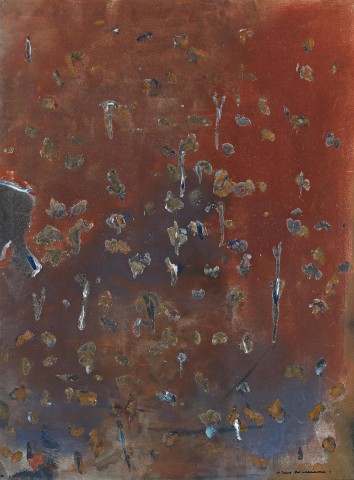KALLISTA HILLSIDE, 1965
FRED WILLIAMS
gouache on paper on composition board
75.0 x 55.0 cm
signed lower right: Fred Williams.
bears inscription verso: No. 912
Alan and Nola Geddes, Sydney
Estate of Nola Geddes, Sydney
We are grateful to Lyn Williams for her assistance in cataloguing this work.
Kallista Hillside, 1965 is one of the finest gouaches Fred Williams painted. It comes from a period of outstanding creativity, which included such masterpieces as Upwey Landscape I, 1965, in the collection of British Petroleum, London; Upwey Landscape II, 1965, in the National Gallery of Australia, Canberra; and Upwey Landscape V, 1965, now in the Art Gallery of Ballarat, Victoria through the bequest of Blair Ritchie. Hailed as being ‘at his best’ in his solo show at Rudy Komon’s gallery in September 1966, Wallace Thornton in The Sydney Morning Herald presciently observed: ‘There is every chance he will go down in history as Australia’s greatest landscape artist’.1 Consisting of twelve oils and the same number of supporting gouaches, together with some etchings, the exhibition was packed with treasures. They included both oils and gouaches from the Waterpond in Landscape series, Green Cloud and Owl, 1966, one time in the Mertz Collection, USA, and Red Landscape, 1966. Of the latter, Patrick McCaughey commented perceptively: ‘The quality of the gouache for Red Landscape, possibly finer than the oil painting itself, suggests Williams was looking for a painting that would come out at a single shot, not something to be laboured over’.2 The same can be said of our gouache, Kallista Hillside, the fluidity of the medium again providing for the more immediate and totally harmonious realisation.
Williams often exhibited gouaches with his oil paintings, their importance in his oeuvre continuing to be recognised in later major shows including the National Gallery of Australia’s 2011 retrospective, Fred Williams: Infinite Horizons. In 1971 Williams devoted an entire exhibition to ‘watercolours’. Shown at the Newcastle Art Gallery before touring, the fifty works, selected by the artist from his own collection, covered the years 1957 to 1971.
Kallista is a small town near Upwey where Williams spent time sketching in watercolour in the early sixties3 and Lyn Williams has identified this gouache, dated October 1965, as Kallista Hillside. It has all the presence of a major work embracing the exploration of pictorial space and the individuality of his vision of the Australian landscape. Ambiguity and no focal point add to its enticement. The absence of horizon and sky gives intensity to the aerial view and interplay between flattened ground and animated, seemingly floating surface details of the bush. There is a marvellous play between close up and distance as dabs, dashes and lines of paint metamorphose into bushes, lichen, or the run of sap into tree trunks, highlighted by touches of white. Add to this the appeal of texture and colour to transform the flat, monochromatic field of reddish brown into a variety of features and hues, brooded over by shadows cast in blue. To the far left suggestions of the outline of a water pond introduce a motif that reappears in the previously mentioned Waterpond in Landscape series of 1966, Waterpond in a Landscape I, 1966 once being in the collection of James Fairfax. Is Kallista Hillside 1965 a harbinger?
1. Gleeson, J., Sun, Sydney, 12 October 1966; Thornton, W., ‘Is this our greatest landscape painter?’, Sydney Morning Herald, Sydney, 12 October 1966, p. 22
2. McCaughey, P., Fred Williams, Murdoch Books, Sydney, 1996, p. 176
3. Mollison, J., A Singular Vision: The Art of Fred Williams, Australian National Gallery, Canberra, 1989, p. 87
DAVID THOMAS
